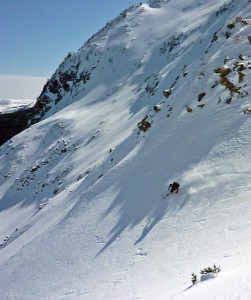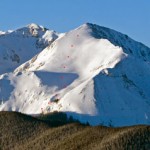
A moderate pace up the moderate slope, as an avalanche instructor/forecaster, Josh knows better than to assume the moderate rating is as safe as it sounds.
If you haven’t checked the CAIC website as of late, the current avalanche danger rating for the Aspen zone is moderate on all aspects and elevations. With five ratings on the avalanche danger scale– low, moderate, considerable, high and extreme– moderate is just a notch above low, the safest rating possible. To look at it another way, if the ratings were assigned numerical values from one to five, then moderate would be a two. A danger rating of two out of five might suggest a fairly high level of confidence in the snow stability, right?
But what about all the talk a few weeks back of sensitive snowpacks and abundant weak layers out there? Did that change? Is moderate really as safe as it sounds?
After asking these questions to Amos Whiting and Josh Hirschberg, a couple of local guide friends/snow science gurus, they agreed that moderate was the appropriate rating according to the defined danger scale, but admitted the simple rating system doesn’t always tell the whole story. To help explain, listed below are the risk rating definitions and associated probability of an event:
- Low– Natural avalanches very unlikely. Human triggered avalanches unlikely.
- Moderate– Natural avalanches unlikely. Human triggered avalanches possible.
- Considerable – Natural avalanches possible. Human triggered avalanches probable.
- High – Natural and human triggered avalanches likely.
- Extreme – Widespread natural or human triggered avalanches certain.

Off the top everything was OK, if not very good. It’s not always the first skier or the first turns off the summit that are the highest risk.
As Josh explained, moderate and considerable are really quite similar. Both ratings have nearly identical phrasing in regards to the likelihood of triggered slides– that human triggered avalanches are “probable” when rated considerable, and “possible” when it’s moderate. I’ll speak for myself here, but if I was told I would “probably” trigger a slide, my attitude wouldn’t be much different than if I was told I would “possibly” trigger one. I’d follow the same safety protocols either way.
And the differences between the two ratings? Well, it mostly has to do with the occurrence of natural slides. Terrain where recent natural slides are observed earn a considerable rating and absence any, it goes down to moderate. In other words, the snowpack can stay the same with the same dangerous layers still present, but the rating goes down a notch to the more benign sounding moderate, once the natural slide cycle ends a few days after a storm. Is it really safer though?

Josh arcs a turn in the Twin Gullies section with the Stammberger face in the background.
But another important difference lies in the fact that as individual words they offer much different levels of confidence, which contributes to a false sense of security. Moderate and considerable ratings might be similar by definition, but the word “moderate” is much less threatening and when combined with the perceived 2 out of 5 danger rating, can understandably cause some to let their guard down and believe everything is safe. And that’s when accidents happen. According to Amos, statistics show that more accidents occur in terrain rated moderate than in high or extreme, likely because it’s wrongly assumed that the former is safe while the latter two are clearly dangerous and are thus avoided.
To cut to the chase, Hayden’s been looking pretty good, and after talking with Josh, we decided to go take a look on Thursday. As it turned out, there was another group at the trailhead who had the same idea. We started up and shortly thereafter, the other group of three followed, though not exactly.
Apart from a somewhat shallow snowpack in parts for the March date, we observed no settling, cracking, whumpfing or other signs of instability resulting from our presence. Remnants of old natural slides were seen, with nothing that appeared to be too recent. Solar aspects were showing effects from the sun and up high there was a bit of a wind affected crust developing on the snow. The entire 3+ hour ascent was without incident. The group that followed reached the ~13,300 foot summit a short while after us, and told us that lower down they had triggered a pretty good size slide. They decided to cut a different skin track, higher on a sunny aspect so as to avoid being low in the gully (on our route) and they kicked off a large slab that slid on old faceted snow near the ground, completely burying our skin track a mere twenty minutes after we were there. No one was hurt.

There I am, looking pretty small against the slide area. We followed what is considered to be the standard route up, just to the left of the photo, across the bottom of the slide path. Twenty minutes later, the other group, in an effort to avoid our gully, cut a track above this slope and triggered the slide. Our skin track was piled high with debris. (Josh Hirshberg photo)
So there’s your moderate stability, or lack thereof. Though it didn’t run far, it was very wide and moved enough snow to seriously ruin your day. Those familiar with the area can debate the pros and cons of the choices made by everyone, as Josh and I did, but remember– decision making in hindsight, when you know the outcome, is really pretty easy. That might be a story for another time.

Doesn’t look too moderate to me. In this case the question is- might it be better to move through an area on more stable snow without incident if it’s a terrain trap? Or to avoid the terrain trap and cut a route across the top of an avalanche slope and trigger a slide and risk getting swept away in it? Even in hindsight it’s hard to say but either way you should be ready for anything.
What’s important to me, and the point of this all, is that moderate danger is more a cause for concern than a reason to relax. Don’t fall into the habit of assuming moderate to mean stable, because it’s not. It can go just as big on any day with any rating. So don’t get complacent out there because if something slides on a moderate day, as Amos told me,”You don’t die moderately.”












4 Comments
Leave your reply.